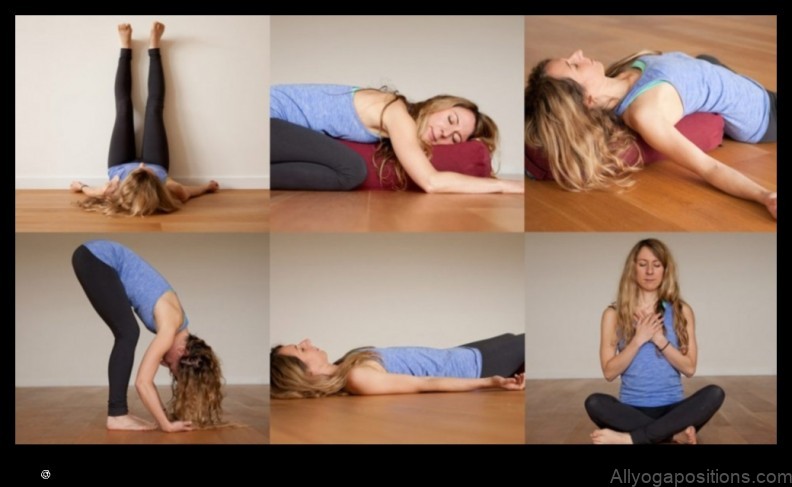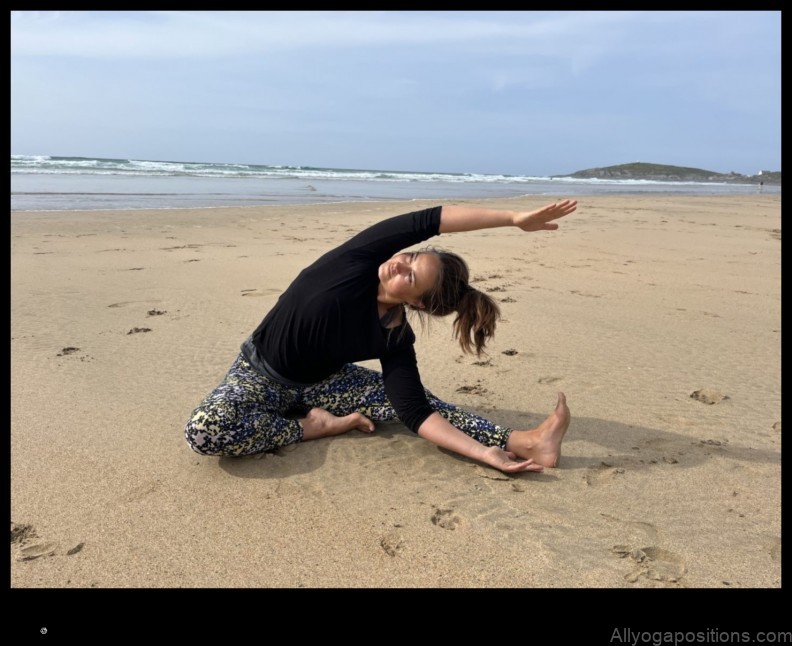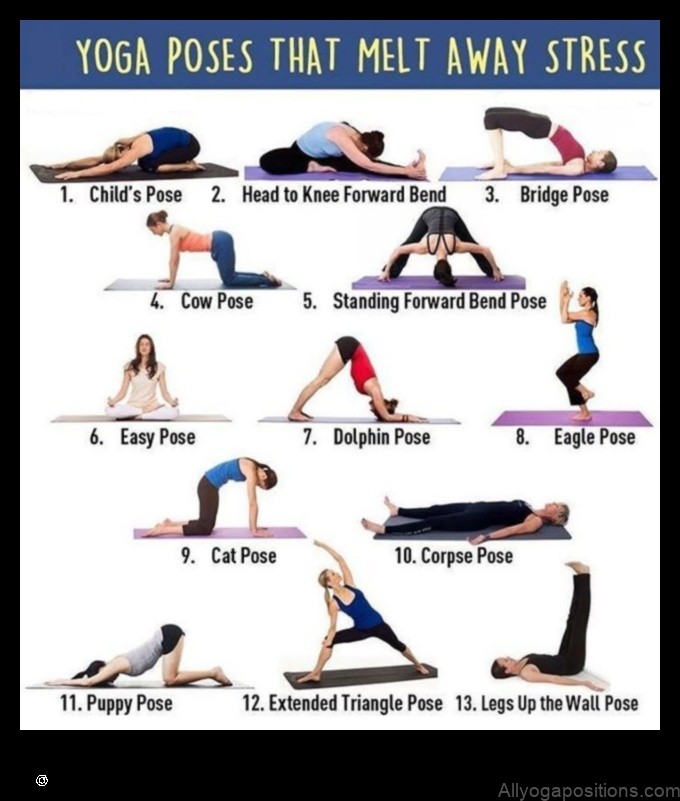
Yoga Poses for Stress Relief
Yoga is a great way to relieve stress and anxiety. It can help to improve mental health and well-being, as well as flexibility, strength, and balance.
This article provides a comprehensive guide to yoga poses for stress relief. It includes information on the benefits of yoga for stress relief, the different types of yoga poses that can be helpful for stress relief, how to do yoga for stress relief, and common mistakes to avoid when doing yoga for stress relief.
If you are looking for a way to relieve stress and anxiety, yoga is a great option. It is a safe and effective way to improve your mental and physical health.

Benefits of Yoga for Stress Relief
Yoga has been shown to have a number of benefits for stress relief, including:
- Reduced stress levels
- Improved mood
- Increased relaxation
- Improved sleep
- Reduced pain
- Improved flexibility
- Increased strength
- Improved balance
Yoga can help to relieve stress by:
- Lowering blood pressure
- Reducing heart rate
- Relaxing muscles
- Increasing oxygen levels
- Releasing endorphins
Yoga is a safe and effective way to relieve stress and improve your overall health and well-being.
Types of Yoga Poses for Stress Relief
There are many different types of yoga poses that can be helpful for stress relief. Some of the most common poses include:
- Child’s pose
- Cat/cow pose
- Downward-facing dog pose
- Seated forward bend
- Plow pose
- Savasana (corpse pose)
These poses are all designed to help you relax and release tension. They can be done in any order, and you can stay in each pose for as long as you like.
If you are new to yoga, it is a good idea to start with gentle poses and gradually work your way up to more challenging poses. You should also listen to your body and stop if you feel pain.

How to Do Yoga for Stress Relief
Here are some tips for doing yoga for stress relief:
- Find a quiet place where you can relax and won’t be interrupted.
- Wear comfortable clothing that you can move around in easily.
- Start with a few deep breaths to relax your body and mind.
- Do each pose slowly and mindfully, focusing on your breath and the sensations in your body.
- Listen to your body and stop if you feel pain.
- Take your time and enjoy the experience.
Yoga is a great way to relieve stress and improve your overall health and well-being. By following these tips, you can get the most out of your yoga practice.

Common Mistakes to Avoid When Doing Yoga for Stress Relief
There are a few common mistakes that people make when doing yoga for stress relief. These mistakes can make your yoga practice less effective and even harmful.
- Pushing yourself too hard.
- Trying to do too much too soon.
- Not listening to your body.
- Not taking breaks.
- Not practicing regularly.
To avoid these mistakes, it is important to:
- Start slowly and gradually increase the intensity of your practice over time.
- Listen to your body and stop if
Topic Features Yoga Poses for Stress Relief – Helps to relieve stress and anxiety Yoga for Stress Relief – Improves mental health and well-being Stress Relief Yoga – Improves flexibility, strength, and balance Yoga Poses to Relieve Stress – Helps to connect with the body and mind Yoga Poses for Anxiety – Helps to relieve pain II. Benefits of Yoga for Stress Relief
Yoga has been shown to have a number of benefits for stress relief, including:
* Reducing stress hormones
* Improving mood
* Increasing relaxation
* Improving sleep
* Boosting energy
* Reducing pain
* Improving flexibility
* Increasing strength
* Improving balance
* Connecting with your body and mindIII. Types of Yoga Poses for Stress Relief
There are many different types of yoga poses that can be helpful for stress relief. Some of the most common include:
- Cat-Cow Pose
- Downward-Facing Dog Pose
- Child’s Pose
- Seated Forward Fold
- Supta Baddha Konasana (Reclining Bound Angle Pose)
- Plow Pose
- Bridge Pose
- Savasana (Corpse Pose)
These poses are all designed to help you relax and release tension. They can be done in any order, and you can stay in each pose for as long as you like.
IV. How to Do Yoga for Stress Relief
Yoga is a mind-body practice that can help to relieve stress in a number of ways. Here are some tips for how to do yoga for stress relief:
* Start by choosing a quiet place where you can relax and focus on your practice.
* Wear comfortable clothing that you can move around in easily.
* Turn off your phone and other distractions.
* Begin your practice with some deep breathing exercises.
* Focus on your breath as you move through the yoga poses.
* Listen to your body and modify the poses as needed.
* End your practice with some relaxation techniques, such as savasana (corpse pose).Yoga is a gentle and effective way to relieve stress and improve your overall well-being. By following these tips, you can get the most out of your yoga practice and enjoy the many benefits that it has to offer.
V. Common Mistakes to Avoid When Doing Yoga for Stress Relief
When doing yoga for stress relief, it is important to avoid making common mistakes. These mistakes can actually make stress worse, or they can prevent you from getting the full benefits of yoga.
Here are some of the most common mistakes to avoid when doing yoga for stress relief:
- Pushing yourself too hard. It is important to listen to your body and not push yourself too hard. If you feel pain, stop and rest.
- Comparing yourself to others. Everyone is different and everyone has their own unique practice. Don’t compare yourself to others, just focus on your own practice and what feels good for you.
- Doing yoga in a stressful environment. If you are feeling stressed, it is important to find a place to do yoga where you can relax and feel comfortable.
- Not taking breaks. It is important to take breaks throughout your yoga practice. This will help you to stay relaxed and focused.
- Not breathing properly. Breathing is an important part of yoga. Make sure to breathe deeply and slowly throughout your practice.
By avoiding these common mistakes, you can make your yoga practice more effective for stress relief.
VI. Yoga Poses for Beginners
Yoga poses for beginners are designed to help you build strength, flexibility, and balance. They are also designed to help you relax and de-stress. Some of the most common yoga poses for beginners include:
- Standing poses, such as Mountain Pose and Warrior Pose
- Seated poses, such as Easy Pose and Child’s Pose
- Twisting poses, such as Half Spinal Twist and Seated Twist
- Bending poses, such as Forward Fold and Downward Dog
- Inverted poses, such as Headstand and Shoulder Stand
When practicing yoga poses for beginners, it is important to listen to your body and do not push yourself too hard. If you feel pain, stop the pose and rest. You should also focus on your breath and relax your mind.
Yoga is a great way to relieve stress and anxiety, improve your flexibility, strength, and balance, and connect with your body and mind. If you are new to yoga, start with beginner poses and gradually increase the difficulty as you get stronger and more flexible.
VII. Yoga Poses for Intermediate Practitioners
Yoga poses for intermediate practitioners are designed to challenge your body and mind while still being accessible to those who have been practicing yoga for a few months or more. These poses are typically more difficult than beginner poses, but they are not as challenging as advanced poses.
Some examples of yoga poses for intermediate practitioners include:
- Warrior II pose
- Extended Side Angle pose
- Downward-Facing Dog pose
- Upward-Facing Dog pose
- Half Moon pose
- Crow pose
- Plow pose
- Headstand pose
- Shoulderstand pose
When practicing yoga poses for intermediate practitioners, it is important to listen to your body and modify the poses as needed. If a pose is too difficult, you can come out of it or modify it to make it easier. It is also important to focus on your breath and to relax your mind as you practice.
Yoga poses for intermediate practitioners can help you to improve your flexibility, strength, and balance. They can also help you to reduce stress and anxiety, improve your mood, and connect with your body and mind.
VIII. Yoga Poses for Advanced Practitioners
Yoga poses for advanced practitioners are designed to challenge the body and mind. They are often held for longer periods of time and require more strength and flexibility.
Some of the benefits of practicing yoga poses for advanced practitioners include:
* Increased strength and flexibility
* Improved balance and coordination
* Reduced stress and anxiety
* Improved sleep
* Enhanced mood
* Increased energy levels
* Improved overall well-beingHere are some examples of yoga poses for advanced practitioners:
* Pincha Mayurasana (Forearm Stand)
* Urdhva Dhanurasana (Wheel Pose)
* Sirsasana (Headstand)
* Sarvangasana (Shoulder Stand)
* Padahastasana (Feet to Head Pose)If you are new to yoga, it is important to start with the basics and work your way up to more challenging poses. Always listen to your body and do not push yourself beyond your limits. If you have any concerns, consult with a doctor or qualified yoga instructor.
IX. Yoga for Stress Relief at Home Yoga can be a great way to relieve stress and anxiety at home. Here are a few tips for getting started:
- Find a quiet place in your home where you can practice yoga without distractions.
- Wear comfortable clothing that you can move around in easily.
- Start with a few simple poses and gradually increase the length and difficulty of your practice as you feel comfortable.
- Focus on your breath and let go of any thoughts that come into your mind.
- Listen to your body and stop if you feel pain or discomfort.
Here are some simple yoga poses that you can try at home to relieve stress and anxiety:
- Child’s pose
- Cat-cow pose
- Downward-facing dog pose
- Seated forward bend
- Savasana (Corpse pose)
Yoga is a safe and effective way to relieve stress and anxiety at home. By following these tips, you can create a relaxing and enjoyable yoga practice that will help you to feel your best.
FAQ
Q: What are the benefits of yoga for stress relief?
A: Yoga can help to relieve stress in a number of ways. It can help to improve your mood, reduce your heart rate and blood pressure, and increase your flexibility and strength. Yoga can also help you to connect with your body and mind, and to learn how to manage stress in a healthy way.
Q: What are the different types of yoga poses for stress relief?
A: There are many different types of yoga poses that can be helpful for stress relief. Some of the most common include:
- Child’s pose
- Cat/cow pose
- Downward-facing dog
- Seated forward bend
- Savasana
Q: How do I do yoga for stress relief?
A: Here are a few tips for doing yoga for stress relief:
- Start with a gentle warm-up.
- Focus on your breath and your body.
- Listen to your body and modify poses as needed.
- Take your time and enjoy the practice.
Table of Contents
Maybe You Like Them Too
